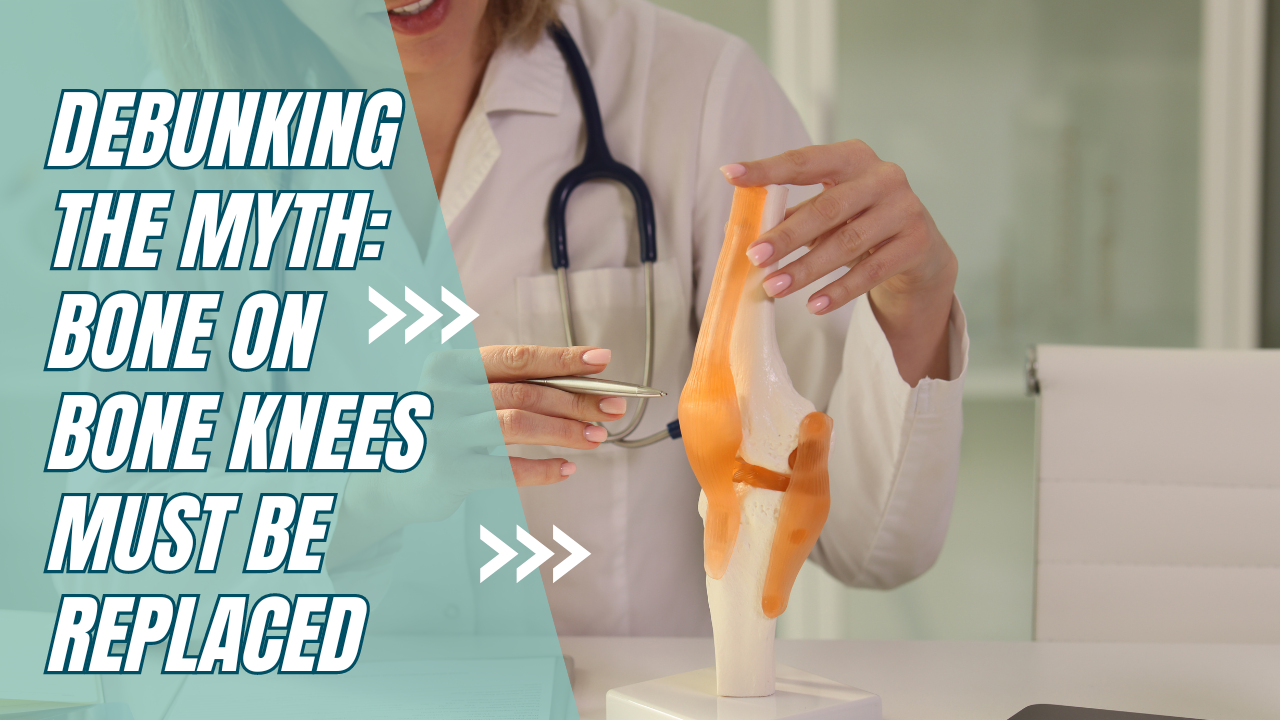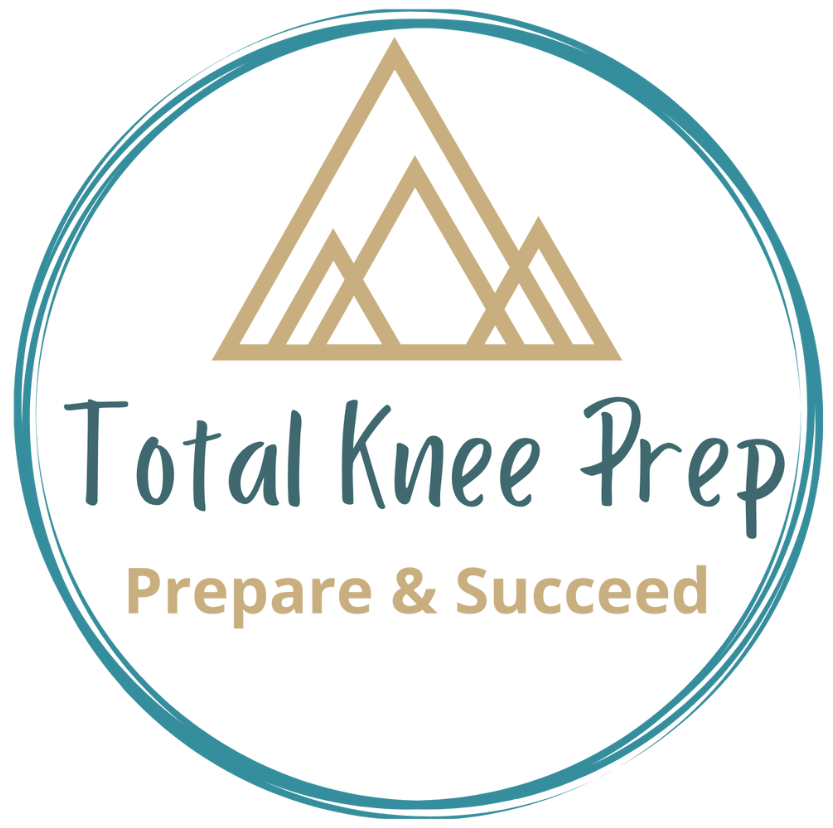
Bone on Bone Myth
Dispelling the Myth:
Bone-on-Bone Knee Arthritis Doesn't Always Mean You Need a Total Knee Replacement
For individuals experiencing chronic knee pain and discomfort, receiving an X-ray with the diagnosis of "bone-on-bone" can be alarming and distressing.
It is a common misconception that this condition automatically requires knee replacement surgery.
However, it is crucial to dispel this myth and understand that the presence of bone-on-bone in an X-ray is just one aspect of diagnosing knee conditions

Understanding Bone-on-Bone in Knee X-Rays
Bone-on-bone in knee X-rays refers to the condition where the protective cartilage that cushions the ends of the bones in the knee joint has significantly worn down, leaving bone surfaces to rub against each other. While this is a serious indication of knee degeneration, it does not necessarily mean an immediate need for knee replacement surgery.
The Complexity of Knee Pain
Knee pain is a complex issue that can be caused by various factors, such as osteoarthritis, injuries, overuse, or muscle imbalances. It is essential to consider the patient's overall health, medical history, lifestyle, and activity level before deciding on a treatment plan. Knee replacement should only be considered after exhausting conservative and less invasive treatment options.
In this blog post, we will debunk the myth that a bone-on-bone diagnosis necessitates knee replacement surgery by examining three key studies that highlight the benefits of physical therapy in managing bone-on-bone knee arthritis.
1. "Physical Therapy and Exercise for Knee Osteoarthritis" (2014)
This review article discusses the effectiveness of physical therapy and exercise in managing knee osteoarthritis. It highlights the benefits of exercise therapy in reducing pain and improving function, even in patients with advanced osteoarthritis.
2. "Physical Therapy as Good as Surgery and Less Risky for One Type of Meniscus Tear" (2013)
This study compared the effectiveness of physical therapy and surgery for meniscal tears in the knee. The results showed that physical therapy was as effective as surgery in relieving pain and improving function, suggesting that surgery may not always be necessary for certain knee conditions.
3. "Physical Therapy Versus Glucocorticoid Injection for Osteoarthritis of the Knee" (2020)
This study compared the effectiveness of physical therapy and glucocorticoid injection for knee osteoarthritis. The results showed that physical therapy was superior to injections in improving function and reducing pain, supporting the use of physical therapy as a first-line treatment for knee osteoarthritis.
4. "Management of Knee Osteoarthritis: A Multimodal Approach" (2012)
This article discusses the importance of using a multimodal approach, including physical therapy, weight management, and medications, in the management of knee osteoarthritis. It emphasizes that knee replacement should be considered only after other treatments have been exhausted.
5. "Physical Therapy for Knee Osteoarthritis: Is It Effective?" (2000)
This study compared physical therapy with a standardized home exercise program in patients with knee osteoarthritis. The results showed that physical therapy was more effective in reducing pain and improving function, highlighting its role as a non-surgical treatment option
Conclusion
These studies provide compelling evidence that physical therapy is a highly effective treatment option for managing bone-on-bone knee arthritis. While knee replacement surgery may be necessary in some cases, it is not the only option. Physical therapy can reduce pain, improve function, and enhance the quality of life for patients with this condition. Therefore, it is crucial for individuals with bone-on-bone knee arthritis to explore conservative treatments, including physical therapy, before considering surgery. By dispelling the myth that knee replacement is the only solution, we can empower patients to make informed decisions about their treatment and improve their overall quality of life.
Knee replacement surgery should be reserved for those cases where non-surgical options have proven ineffective, and the pain significantly impairs the patient's ability to lead a normal life. By staying informed and exploring all possible treatments, individuals can make well-informed decisions about their knee health and pursue the most appropriate course of action to regain their mobility and alleviate pain.
To see all these tips in action - watch the video ⬇
For any other science nerds out there who'd like to read more about the articles discussed in this article
"Physical Therapy and Exercise for Knee Osteoarthritis"
Authors: Fransen, M., McConnell, S., Harmer, A.R., et al.
Journal: The Journal of Orthopaedic and Sports Physical Therapy / Date Published: 2014
"Physical Therapy as Good as Surgery and Less Risky for One Type of Meniscus Tear"
Authors: Katz, J.N., Brophy, R.H., Chaisson, C.E., et al.
Journal: The New England Journal of Medicine / Date Published: 2013
"Physical Therapy Versus Glucocorticoid Injection for Osteoarthritis of the Knee"
Authors: Deyle, G.D., Henderson, N.E., Matekel, R.L., et al.
Journal: Annals of Internal Medicine / Date Published: 2020
"Management of Knee Osteoarthritis: A Multimodal Approach"
Authors: Hochberg, M.C., Altman, R.D., April, K.T., et al.
Journal: Osteoarthritis and Cartilage / Date Published: 2012
"Physical Therapy for Knee Osteoarthritis: Is It Effective?"
Authors: Deyle, G.D., Allison, S.C., Matekel, R.L., et al.
Journal: Annals of Internal Medicine / Date Published: 2000
Do you want to get stronger, fitter, and reduce your knee pain before surgery... then join the Total Knee Prep Course and in only 6 weeks transform your strength and confidence from the comfort of your own home.
Imagine waking up after surgery feeling relaxed but excited to get started on your knee rehab, with an inner confidence that you have all the skills and tools you ’ll need to get moving on your own, start exercising, and controlling your knee pain during your recovery
If you already know that you are going to have a knee replacement and you want to prepare to have a successful recovery after surgery, then joining the Total Knee Prep Course is the next best step you can take.
'“Healing is an art. It takes time, it takes practice, it takes love.” – Maza Dohta

Did you find this post helpful? If you'd like to be updated on new blog posts click below
We'd love to hear any feedback you have about the blog
Come Join us on Social Media
© Copyright 2023 Total Knee Prep.

